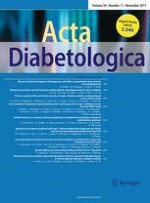Published in:

01-11-2017 | Original Article
Joint modeling of longitudinal autoantibody patterns and progression to type 1 diabetes: results from the TEDDY study
Authors:
Meike Köhler, Andreas Beyerlein, Kendra Vehik, Sonja Greven, Nikolaus Umlauf, Åke Lernmark, William A. Hagopian, Marian Rewers, Jin-Xiong She, Jorma Toppari, Beena Akolkar, Jeffrey P. Krischer, Ezio Bonifacio, Anette-G. Ziegler, TEDDY study group
Published in:
Acta Diabetologica
|
Issue 11/2017
Login to get access
Abstract
Aims
The onset of clinical type 1 diabetes (T1D) is preceded by the occurrence of disease-specific autoantibodies. The level of autoantibody titers is known to be associated with progression time from the first emergence of autoantibodies to the onset of clinical symptoms, but detailed analyses of this complex relationship are lacking. We aimed to fill this gap by applying advanced statistical models.
Methods
We investigated data of 613 children from the prospective TEDDY study who were persistent positive for IAA, GADA and/or IA2A autoantibodies. We used a novel approach of Bayesian joint modeling of longitudinal and survival data to assess the potentially time- and covariate-dependent association between the longitudinal autoantibody titers and progression time to T1D.
Results
For all autoantibodies we observed a positive association between the titers and the T1D progression risk. This association was estimated as time-constant for IA2A, but decreased over time for IAA and GADA. For example the hazard ratio [95% credibility interval] for IAA (per transformed unit) was 3.38 [2.66, 4.38] at 6 months after seroconversion, and 2.02 [1.55, 2.68] at 36 months after seroconversion.
Conclusions
These findings indicate that T1D progression risk stratification based on autoantibody titers should focus on time points early after seroconversion. Joint modeling techniques allow for new insights into these associations.